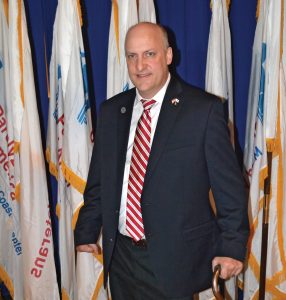Trying to put meaning to the state of the country, PVA president discusses our new normal
By David Zurfluh
I hope you, your families, caregivers and friends are safe and well.
As I write this column in July, we hear news of possible novel coronavirus (COVID-19) vaccines starting to surface, however, experts will continue to debate their effectiveness. We’re told that by this fall, we could expect several possible vaccines, but when and how they can be available to everyone is still being calculated and heavily debated.
That being said, what has your life and normalcy been like these last six months, and what will it look like these next six months, vaccine or not?
Before COVID-19, I liked to go to church, movies, museums, parks, travel (by plane mostly), exercise, participate in sports and visit family and friends. While some of these activities can be done from home, some are just not available and others carry severe restrictions and higher risk with this relentless pandemic.
How we each proceed individually in this era of COVID-19 will ultimately define normalcy for us for the next two to three years, possibly longer. Our individual choices and actions moving forward will impact us personally and collectively at many levels, physically, mentally, socially and even career-wise.
When listening to news about COVID-19 on TV, radio, internet or social media, one thing becomes glaringly clear — nothing seems 100% accurate. I will say on a positive note that the information on Paralyzed Veterans of America’s (PVA) COVID-19 website (pva.org/covid-19) and the Centers for Disease Control and Prevention site (cdc.gov) are great resources when making decisions on how to best go about your daily life in the months ahead.
From my perspective, there are several categories (groups) of people I have seen form over the past four to five months:
1) The group too anxious and scared to go out of their homes or protective lifestyles because of personal health conditions or fear of catching the virus (rightly so or not).
2) Those scared at first to go out, but who have learned to adjust their lifestyles by routinely wearing personal protective equipment (PPE), following guidelines and cautiously venturing out to get necessary supplies and doing occasional medical appointments or even something fun.
3) The group trying to figure out what the virus is, what it can do and how to live with it all around us while doing the most things in life available, and at the same time wearing a mask, PPE, washing their hands, practicing social distancing and following recommended guidelines.
4) The gamblers. They don’t wear masks, hate being told what to do, are willing to roll the dice and hope they don’t catch anything or get sick (not too worried about others).
5) The last group comprising people who do all of the above from day to day or week to week.
For the record, I align with the third group.
I can only speak for myself, but the last six months have been draining mentally and physically. I can only imagine it’s also been the same, or at least very similar, for all in our PVA universe. As summer turns to autumn and the long brighter days diminish, I suggest that you evaluate where you are emotionally and physically and then intentionally plan, as best you can, what your COVID-19 life will look like in the next six months.
Soon winter will follow, and the virus will unfortunately still be in circulation, but hopefully, we may have a vaccine to effectively fight it. Like the flu, cold and other bugs, COVID-19 will be with us for a long time, perhaps our lifetimes and beyond. How we choose to live with this reality, though, will define our new normalcy in the years to come. n



